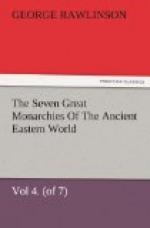To these constructions may be added, on the authority either of Nebuchadnezzar’s own inscriptions or of the existing remains, the Birs-i-Nimrud, or great temple of Nebo at Bor-sippa; a vast reservoir in Babylon itself, called the Yapur-Shapu; an extensive embankment along the course of the Tigris, near Baghdad; and almost innumerable temples, walls, and other public buildings at Cutha, Sippara, Borsippa, Babylon, Chilmad, Bit-Digla, etc. The indefatigable monarch seems to have either rebuilt, or at least repaired, almost every city and temple throughout the entire country. There are said to be at least a hundred sites in the tract immediately about Babylon, which give evidence, by inscribed bricks bearing his legend, of the marvellous activity and energy of this king.
We may suspect that among the constructions of Nebuchadnezzar was another great work, a work second in utility to none of those above mentioned, and requiring for its completion an enormous amount of labor. This is the canal called by the Arabs the Kerek Saideh, or canal of Saideh, which they ascribe to a wife of Nebuchadnezzar, a cutting 400 miles in length, which commenced at Hit on the Euphrates, and was carried along the extreme western edge of the alluvium close to the Arabian frontier, finally falling into the sea at the head of the Bubian creek, about twenty miles to the west of the Shat el-Arab. The traces of this canal which still remain indicate a work of such magnitude and difficulty that we can scarcely ascribe it with probability to any monarch who has held the country since Nebuchadnezzar.
The Pallacopas, or canal of Opa (Palga Opa), which left the Euphrates at Sippara (Mosaib) and ran into a great lake in the neighborhood of Borsippa, whence the lands in the neighborhood were irrigated, may also have been one of Nebuchadnezzar’s constructions. It was an old canal, much out of repair, in the time of Alexander, and was certainly the work, not of the Persian conquerors, but of some native monarch anterior to Cyrus. The Arabs, who call it the Nahr Abba, regard it as the oldest canal in the country.
Some glimpses into the private life and personal character of Nebuchadnezzar are afforded us by certain of the Old Testament writers. We see him in the Book of Daniel at the head of a magnificent Court, surrounded by “princes, governors, and captains, judges, treasurers, councillors, and sheriffs;” waited on by eunuchs selected with the greatest care, “well-favored” and carefully educated; attended, whenever he requires it, by a multitude of astrologers and other “wise men,” who seek to interpret to him the will of Heaven. He is an absolute monarch, disposing with a word of the lives and properties of his subjects, even the highest. All offices are in his gift. He can raise a foreigner to the second place in the kingdom, and even set him over the entire priestly order. His wealth is enormous, for he makes of pure gold an image, or obelisk, ninety feet high and




